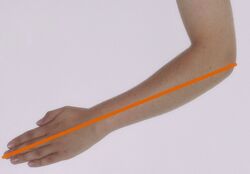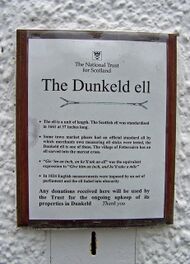Ell
| Ell | |
|---|---|
 The ell was originally a cubit, later replaced by the cloth-ell or "double ell". | |
| General information | |
| Unit of | Length |
| Conversions (imperial) | |
| 1 imp unit in ... | ... is equal to ... |
| Inch | 45 |
| Metre | 1.143 |
An ell (from Proto-Germanic *alinō, cognate with Latin ulna)[1] is a northwestern European unit of measurement, originally understood as a cubit (the combined length of the forearm and extended hand). The word literally means "arm", and survives in the form of the modern English word "elbow" (arm-bend). Later usage through the 19th century refers to several longer units,[2][3] some of which are thought to derive from a "double ell".[4][5]
An ell-wand or ellwand was a rod of length one ell used for official measurement. Edward I of England required that every town have one. In Scotland, the Belt of Orion was called "the King's Ellwand".[6][7] An iron ellwand is preserved in the entrance to Stånga Church on the Swedish island of Gotland, indicating the role that rural churches had in disseminating uniform measures.[8]
Several national forms existed, with different lengths, including the Scottish ell (≈37 inches or 94 centimetres), the Flemish ell [el] (≈27 in or 68.6 cm), the French ell [aune] (≈54 in or 137.2 cm),[9] the Poland ell (≈31 in or 78.7 cm), the Denmark alen (24 Danish inches or 2 Danish fod: 62.7708 cm), the Swedish aln (2 Swedish fot 59.38 cm) and the German ell [Elle] of different lengths in Frankfurt (54.7 cm), Cologne, Leipzig (Saxony) or Hamburg.
Select customs were observed by English importers of Dutch textiles; although all cloths were bought by the Flemish ell, linen was sold by the English ell, but tapestry was sold by the Flemish ell.[9]
The Viking ell was the measure from the elbow to the tip of the middle finger, about 18 inches (460 mm). The Viking or primitive ell was used in Iceland up to the 13th century. By the 13th century, a law set the "stika" as equal to 2 ells which was the English ell of the time.[10]
Historic use
England
In England, the ell was usually exactly 45 in (1.143 m), or a yard and a quarter. It was mainly used in the tailoring business but is now obsolete. Although the exact length was never defined in English law, standards were kept; the brass ell examined at the Exchequer by Graham in the 1740s had been in use "since the time of Queen Elizabeth".[11]
Other English measures called an ell include the "yard and handful", or 40 in. ell, abolished in 1439; the yard and inch, or 37 in. ell (a cloth measure), abolished after 1553 and known later as the Scotch ell=37·06; and the cloth ell of 45 in., used until 1600.[12] See yard for details.
Scots
The Scottish ell (Scottish Gaelic: slat thomhais) is approximately 37 inches (0.94 m). The Scottish ell was standardised in 1661, with the exemplar to be kept in the custody of Edinburgh.[13] It comes from Middle English elle.[14]
It was used in the popular expression "Gie 'im an inch, an he'll tak an ell" (equivalent to "Give him an inch and he'll take a mile" or "... he'll take a yard", and closely similar to the English proverb "Give him an inch and he'll take an ell", first published as "For when I gave you an inch, you tooke an ell" by John Heywood in 1546.[15]
The Ell Shop (1757) in Dunkeld, Perth and Kinross (National Trust for Scotland), is so called from the 18th-century iron ell-stick attached to one corner, once used to measure cloth and other commodities in the adjacent market-place. The shaft of the 17th-century Kincardine mercat cross stands in the square of Fettercairn, and is notched to show the measurements of an ell.
Scottish measures were made obsolete, and English measurements made standard in Scotland, by an Act of Parliament, the Weights and Measures Act 1824.
Other
Similar measures include:[12]
- Netherlands: el, 1 metre (Old ell=27.08 inches)
- Jersey: ell, 4 feet
- N. Borneo: ella, 1 yard
- Switzerland: elle, 0.6561 yard
- Ottoman Turkey: Arşın, ~69 cm
In literature
Ells are used for measuring the length of rope in J. R. R. Tolkien's The Lord of the Rings.[16] Since Sam declares that 30 elles are "about" 18 fathoms (108 feet), he seems to be using the 45-inch English ell, which would work out to 112 feet.
In the epic poem Sir Gawain and the Green Knight, the Green Knight's axe-head was an ell (45 inches) wide.[17]
Ells were also used in the medieval French play The Farce of Master Pathelin to measure the size of the clothing Pierre Pathelin bought.[18]
Halldór Laxness described Örvar-Oddr as twelve Danish ells tall in Independent People, Part II, "Of the World".[19]
References
- ↑ "ell, n.1". OED Online. December 2011. Oxford University Press. (accessed February 20, 2012).
- ↑ The Diagonal. Yale University Press. 1920. p. 98. https://books.google.com/books?id=BudNAAAAYAAJ&q=%22the+ell+was+originally+the+same+measure+as+the+cubit%22&pg=PA98. Retrieved 6 February 2012.
- ↑ Charlton Thomas Lewis; Hugh Macmaster Kingery (1918). An elementary Latin dictionary. American book company. p. 198. https://archive.org/details/bub_gb_2ncKAAAAIAAJ. Retrieved 6 February 2012. "forearm, ell, cubit."
- ↑ James Robinson (of Boston.) (1857). The American elementary arithmetic. J.P. Jewett & co.. p. 94. https://books.google.com/books?id=klYMAAAAYAAJ&pg=PA94. Retrieved 6 February 2012.
- ↑ Daniel O'Gorman (1853). Intuitive calculations; the readiest and most concise methods. p. 48. https://archive.org/details/intuitivecalcul00ogogoog. Retrieved 6 February 2012.
- ↑ infoplease.com, OED s. Ell-wand.
- ↑ AR Littlewood. "The measurements of cricket". ESPN cricinfo. http://content-www.cricinfo.com/ci/content/story/89685.html.
- ↑ Andrén, Anders (2017) (in sv). Det Medeltida Gotland. En arkeologisk guidebok (2nd ed.). Lund: Historiska Media. p. 206. ISBN 978-91-7545-476-4.
- ↑ 9.0 9.1 Brayshaw, Tom S., ed. Brayshaw's Mathematical Desk Companion. Chesterfield, England: Thomas Brayshaw Ltd., Edition 16, 1955
- ↑ Nancy Marie Brown (2007). The Far Traveller: Voyages of a Viking Woman. Harcourt. pp. 236, 276. OCLC 85822467.
- ↑ Knight, Charles (1840). The Penny magazine of the Society for the Diffusion of Useful Knowledge, Volume 9. London: Society for the Diffusion of Useful Knowledge. https://books.google.com/books?id=-BHnAAAAMAAJ.
- ↑ 12.0 12.1 Chisholm, Hugh, ed. (1911). "Weights and Measures" (free fulltext), from the Encyclopædia Britannica. Vol. 01 (11th ed.). Cambridge University Press.
- ↑ Concise Scots Dictionary, chief editor Mairi Robinson, Aberdeen University Press, 1987, p 817
- ↑ "Dictionary of the Scots Language". http://www.dsl.ac.uk/getent4.php?plen=2873&startset=14827060&query=Ell&fhit=ell&dregion=form&dtext=dost#fhit.
- ↑ Heywood, John (1546). A dialogue conteinying the nomber in effect of all the prouerbes in the englishe tongue, compacte in a matter concernyng two maner of mariages, etc.. London: Thomas Berthelet. Full text of 1874 reprint
- ↑ Tolkien, J. R. R. (1997). The Lord of the Rings. HarperCollins. pp. 595–6. ISBN 0-261-10368-7. "Sam paid it out slowly, measuring it with his arms: 'Five, ten, twenty, thirty ells, more or less, ... Thirty ells, or say, about eighteen fathom'"
- ↑ Burrow, J. A., ed (1972). Sir Gawain and the Green Knight. Harmondsworth, England: Penguin. pp. 22. ISBN 0140806679. OCLC 1136028. "The lenkthe of an elnyerde the large hed had"
- ↑ https://warburg.sas.ac.uk/pdf/ebh410b2451866.pdf[bare URL PDF]
- ↑ Laxness, Halldór (1997). Sjálfstætt fólk. Introduction by Brad Leithauser. New York: Vintage. p. 201. ISBN 0-679-76792-4.
- Attribution
Further reading
- Collins Encyclopedia of Scotland
- Scottish National Dictionary and Dictionary of the Older Scottish Tongue
- Weights and Measures, by D. Richard Torrance, SAFHS, Edinburgh, 1996, ISBN:1-874722-09-9 (N.B.: The book focusses exclusively on Scottish weights and measures.)
External links
 |



